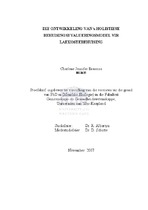| dc.description.abstract | Human ecologists agree with the government’s view that a house encompasses more than a structure, and that its environment and location are equally important in meeting the needs and expectations of the occupants. This study was undertaken to establish whether the planning and building of housing units do indeed comply with government policy and adhere to the set standards for houses being “more than just a structure”. In evaluating the housing act, questions were raised about government’s accountability regarding the enforcement of stipulations, with a view to offering guidelines that could be applied by housing practitioners. The aim of the study was to develop a holistic evaluation model for low-cost housing from the perspective of human ecology. The research aims were to obtain information about circumstances and conditions within a specific community (Objective 1). The study endeavoured to develop a holistic housing evaluation model (Objective 2) based on housing indicators for healthy housing. A questionnaire (objective 3), corresponding with the compound model, was designed to ascertain to which extent the needs of individuals in the Wesbank community (Objective 4) had been met in compliance with the indicators. A community profile (Objective 5) of Wesbank was then drawn up accordingly. Government legislation in respect of low-cost housing in Wesbank was evaluated according to the holistic housing evaluation model (HHEM) to determine to what extent the housing served the needs of families. Evaluation research was undertaken using multiple data collection techniques such as a documentary content analysis, a semantograph, focus groups and a survey conducted by means of a structured questionnaire. The HHEM was compiled by studying government policy and legislation, analysing the literature and identifying indicators as obtained from the focus groups, with the purpose of determining housing quality. By using the HHEM it became possible to identify community needs and other housing aspects, and to draw up a community profile. Meaningful conclusions about problematic areas in this particular environment were then presented visually by means of this model, which could readily be implemented by development practitioners. The HHEM served as a basis for the questionnaire used in a survey conducted in the Wesbank low-cost housing area, evaluating to what extent the project complied with the objective of providing houses that would be more than mere structures. From the findings of the study in Wesbank it appeared that aspects such as the quality of the physical structure, space and privacy, sufficient and sustainable provision of services and accessibility to facilities determine how the occupants of low-cost housing experience their structures. trong opinions have been voiced about a serious shortage of privacy and the poor quality of the housing structures, the latter resulting in conditions of ill health. The research found that housing development in Wesbank definitely did not contribute to improved health and the quality of life amongst the inhabitants. A community profile for Wesbank was then drawn up in response to the results of the survey. Based on the community profile that ensued from the study in Wesbank, it is recommended that educational housing programmes be made available to beneficiaries. Concomitantly, community facilities and physical development should be provided to advance all forms of socio-psychological, cultural and sports development. A study of alternative types of housing, building material and construction techniques needs to be launched to find a suitable product that would contribute to improved health and living conditions. A careful selection of contractors, close monitoring of the construction operations and the application of quality standards should be strictly enforced. Other recommendations are that developers hould first undertake a complete and thorough survey of the beneficiaries of proposed housing developments. The HHEM could be enforced in areas with different economic and income levels, and applied in further research, thereby creating comparative profiles of the respective communities. Participation by beneficiaries should be encouraged in any housing process, as this could possibly ensure the sustainability of their communities. With the HHEM the government and housing developers in new developments could ensure beforehand that the right type of housing will be built and developed for the right type of community. The HHEM can also be applied in existing areas for executing needs studies to serve as a guideline for development. | en_US |

